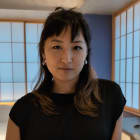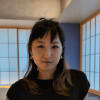Leave aquaculture to the Norwegians, this Singaporean was told. Thankfully, he ignored the naysayers
Marine engineer Leow Ban Tat wasn’t content to sail into a comfortable retirement. With the right technologies, farming methods and government support, he’s living his dream of rearing healthy fish to feed the masses.
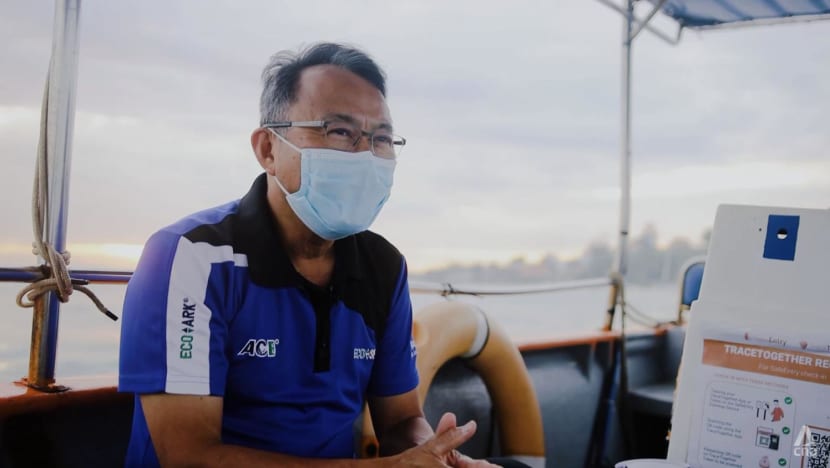
Leow Ban Tat loves the sea and enjoys seeing the sun rise and set each day.
SINGAPORE: As a young man, he answered the call of the sea and went on to a globe-trotting marine engineering career in the oil and gas industry.
At the age of 60, Leow Ban Tat could have been comfortably retired.
Instead, he took the plunge in 2018 to pursue a new dream – that of feeding the masses healthy fish reared in a system insulated from the vagaries of the open sea.
“Our local farmers work very hard. I think they are very experienced,” he said. But events like algal blooms, which can kill massive numbers of fish, leave offshore open-net fish farmers helpless.
Technology, he believes, can overcome these challenges and help the sector produce quality fish.
Leow, 64, began sketching his ideas from around 2014. Oil prices had plunged due to a supply glut. An oil and gas consultant at the time, he thought: “Instead of grumbling about the downturn of the industry, why don’t I just use what I know… to create something new?”
Floating structures were what he knew well. Leow came up with drawings of tanks on a buoyant structure for fish farming. He called his design Eco-Ark and patented it in 2018.
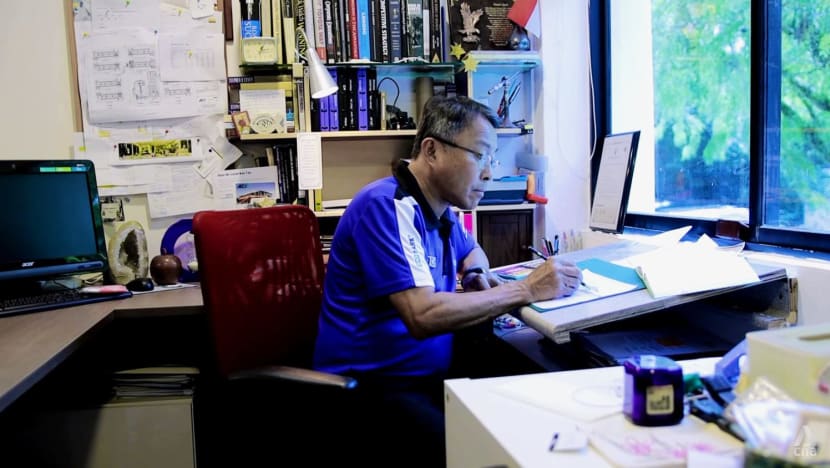
That year, his Chancery Court apartment went en bloc, and Leow decided to take a leap of faith and plow the funds into this new venture.
“When I first started to tell investors that I’m going to build the first Eco-Ark, many of them were very apprehensive,” he said. “They think that this will be a high-capex (capital expenditure) investment that is not proven.”
A friend who used to be a farmer even told him to leave aquaculture to the Norwegians. “I quit this industry because it just cannot make money,” Leow recalled the friend saying. “Your patent, you can just throw away.”
But Leow drew courage from his wife Amy and their four children. She told him: “Maybe you should chase your dream. Don’t stop where you are.”
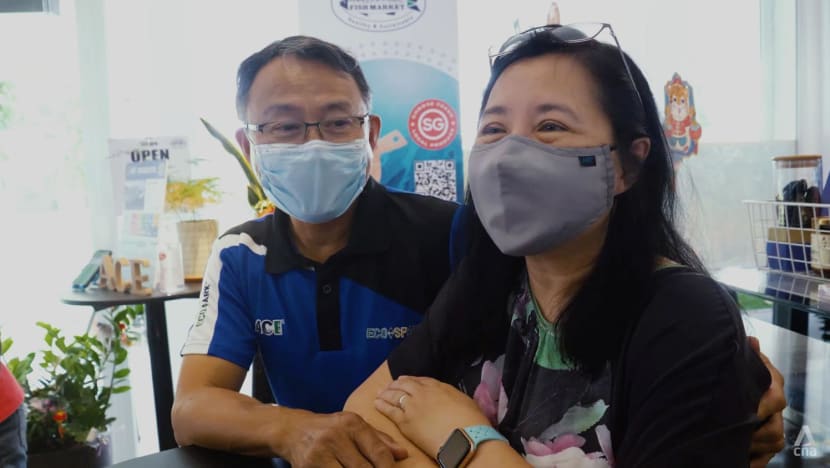
Today, the Aquaculture Centre of Excellence (ACE)’s Eco-Ark is anchored about 5km off Changi Point Ferry Terminal. Installed in October 2019, the 48m by 28m floating structure currently produces almost 100 tonnes of barramundi (Asian sea bass), grouper and red snapper a year.
At full capacity, it can produce 166 tonnes of fish a year, about 20 times that of a traditional farm.
TRANSFORMING AQUACULTURE
Eco-Ark is one of the sea-based fish farms contributing to Singapore’s ambitious ’30 by 30' goal.
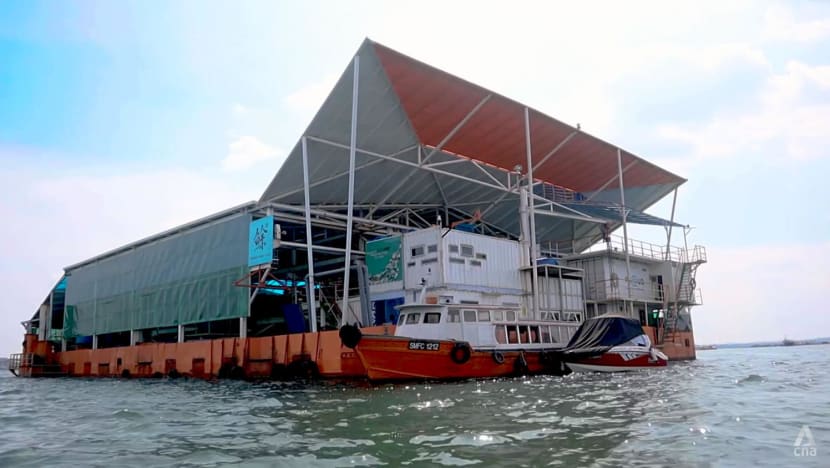
The country aims to build the agri-food industry’s capability and capacity to produce 30 per cent of its nutritional needs by 2030 – up from less than 10 per cent today – by ramping up its productivity in ways that are resource-optimal, climate-resilient, and sustainable both environmentally and commercially.
The government believes fish is a nutritious source of protein that the country can produce sustainably, and the Singapore Food Agency (SFA) aims to give the aquaculture industry a leg-up through various measures.
These include the launch of new sea space tenders in the southern waters and East Johor Straits from the end of this year, with lease tenures of 20+10 years that provide greater certainty so that farmers can plan and invest for the longer term, the agency said this month.
The SFA is also supporting the transformation of the aquaculture sector into a highly productive, climate-resilient and resource-efficient one that leverages technology and appropriate farm management methods.
Interested farms can tap its S$60-million Agri-Food Cluster Transformation (ACT) Fund launched last year. It replaced the Agriculture Productivity Fund which committed over S$50 million to 132 companies – including Eco-Ark – from 2014 to 2021.
As of Dec 31 last year, the agency has received 23 applications for ACT funding. Eight have been approved, while the rest are being processed and evaluated, the SFA said.
The efforts are starting to bear fruit. Last year, Singapore’s fish farms produced 4,200 tonnes of fish, an increase of 33 per cent from a decade ago.
FARM OF THE FUTURE
The Eco-Ark, which cost about S$4.1 million to build, has been held up as a model of innovation by government leaders.
WATCH: Inside Eco-Ark, a high-tech fish farm in Singapore (9:09)
Leow, ACE’s energetic chief executive, enthuses about his vision of feeding as many people as possible. He is equally knowledgeable about how the farm’s water treatment and other technologies enable intensive production.
Seawater to be used for the fish tanks is filtered through drum filters, then ozonated to kill bacteria. Leow opted for ozone instead of ultraviolet technology to kill pathogens because the latter “cannot cope with high volume flow”.
He believes that if water quality is good, there is no need to vaccinate or use antibiotics on the fish.

Besides being equipped with solar panels, the Eco-Ark is also more energy-efficient than some other closed-containment floating farms. According to Leow, the biggest source of energy consumption for farms like his are the water pumps.
To cut energy consumption, he designed the fish tanks to be largely submerged instead of sitting atop the floating structure. This means the pumps only need to pump water to a lower height before gravity causes the water to cascade down to be filtered, then injected with ozone. Clean water then cascades into the fish tanks.
He also ensures the water discharged from tanks back out into the sea are of the same quality or slightly better than what was taken in. Fish waste is removed, and the water is ozonated again before being released.
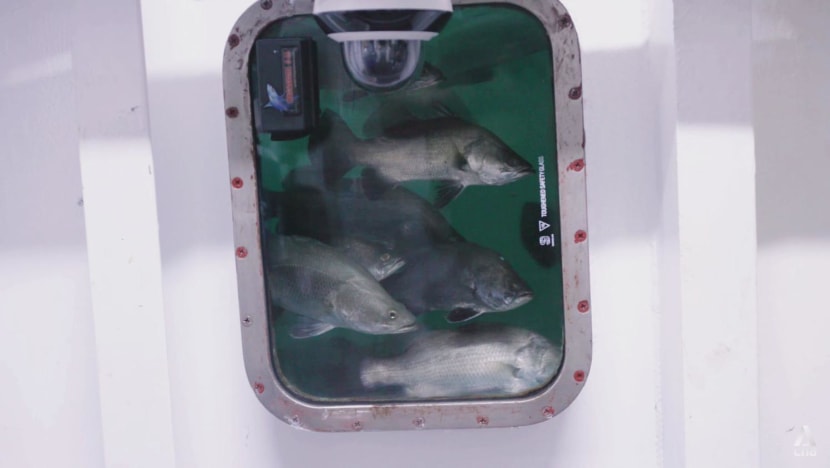
Automation and the Internet of Things (IoT) enable tasks such as monitoring fish growth to be done with minimal labour. At any one time, only six staff are needed to run all operations on board and they are overseen by two farm technicians and an aquaculturist.
Another special feature of the Eco-Ark is its on-board processing facility. The fish are processed – packed in ice or vacuum packed – mere metres from where they are harvested, then transported via a 10-minute boat ride to the mainland where retail and corporate customers await.
FAMILIES USE CDC VOUCHERS TO BUY HIS FISH
ACE opened a retail store in MacPherson in October 2021 and customers have told Leow that his sea bass “do not have a muddy taste” and are “so good”.
“I’m so happy to see families coming down to use their CDC Vouchers (to buy) fish home,” he said.
His work is far from done and expansion plans, including more retail stores, are afoot.

ACE has two more Eco-Arks on the way that will take production to over 500 tonnes a year. It also plans to keep broodfish to produce eggs that will hatch and grow into fingerlings. “By so doing, we become completely self-sustaining, self-sufficient,” said Leow.
While food security was not foremost in his mind when he embarked on his venture – “I was just thinking about how I could produce more fish in a sustainable way” – he now says it is “critically important” for Singapore.
What continues to drive him are passion and his love for the sea.
“Being able to see the sunrise, to see the sunset everyday – sunrise gives new hope, sunset tells us there’s always another day,” he said. “This new career is something I feel passionate about. I tell myself only one thing: Anyone who wants to succeed has to persevere.”
This article by CNA Insider was done in partnership with Singapore Food Agency. For more on how Singapore’s food future is being shaped, visit: www.ourfoodfuture.gov.sg.








